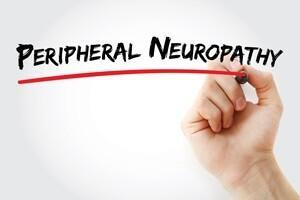Peripheral Neuropathy Explained
 What is Peripheral Neuropathy?
What is Peripheral Neuropathy?
Neuropathy literally means a disease process involving your nervous system. Your body’s nervous system is comprised of two major divisions: the central nervous system and the peripheral nervous system. The central nervous system is comprised of the brain and spinal cord, while the peripheral nervous system makes up those nerves that communicate with the muscles, glands, and organs. Peripheral Neuropathy, specifically, is a disease of the peripheral nervous system.
Causes and Symptoms
If you’ve heard the term peripheral neuropathy, you probably think it is a disease resulting from complications of diabetes. Indeed, 30% of patients suffering with peripheral neuropathy are from complications resulting from diabetes. However, 70% of those with peripheral neuropathy come from other sources.
Other sources of neuropathy are as follows:
- Alcoholism
- Exposure to Toxic Substances
- Infectious Agents (Shingles, Lyme Disease)
- Various Auto-Immune Disorders
- Prescription Medication Induced
- Nutritional Deficiency (B12)
- Chemotherapy Induced
- Compressive Neuropathy (carpal tunnel, sciatica)
- Others
Damage to the peripheral nerves from these various sources manifest with a variety of symptoms to include pain, numbness, tingling, burning, and/or weakness of the extremities. The symptom(s) a person experiences depends on the specific type of nerve(s) damaged.
Diagnosis and Treatments
Diagnosis of neuropathy requires a complete medical history and examination. The examination portion can include, orthopedic evaluation, neurologic evaluation, and blood tests. These tests, when combined with a thorough history, can allow for the diagnosis, as well as identifying the potential underlying cause of the nerve damage.
Successful treatment is dependent upon determining the underlying cause of the nerve damage and the length of time that symptoms have been present. With proper identification of the offending agent, lifestyle, dietary, and/or drug modifications can be sought. Given these changes and sufficient time, the peripheral nerves can heal and regenerate in many cases.
Various FDA cleared therapeutic modalities are available today to help stimulate nerve healing and reduce symptoms. Regenerative medicine is showing great promise towards helping those suffering with peripheral neuropathy. Specifically, mesenchymal stem cells (MSC) have been shown to be very effective for those with diabetic neuropathy.
It is important for those that are experiencing symptoms of neuropathy (numbness, tingling, burning, weakness, etc.) seek attention sooner than later. The longer the symptoms are experienced, the less likely the peripheral nerves can regenerate.
Learn More About Neuropathy!
If you would like to request additional information about neuropathy, >>> Click Here!
-Dr. Ryan Roth, D.C.

 What is Peripheral Neuropathy?
What is Peripheral Neuropathy?